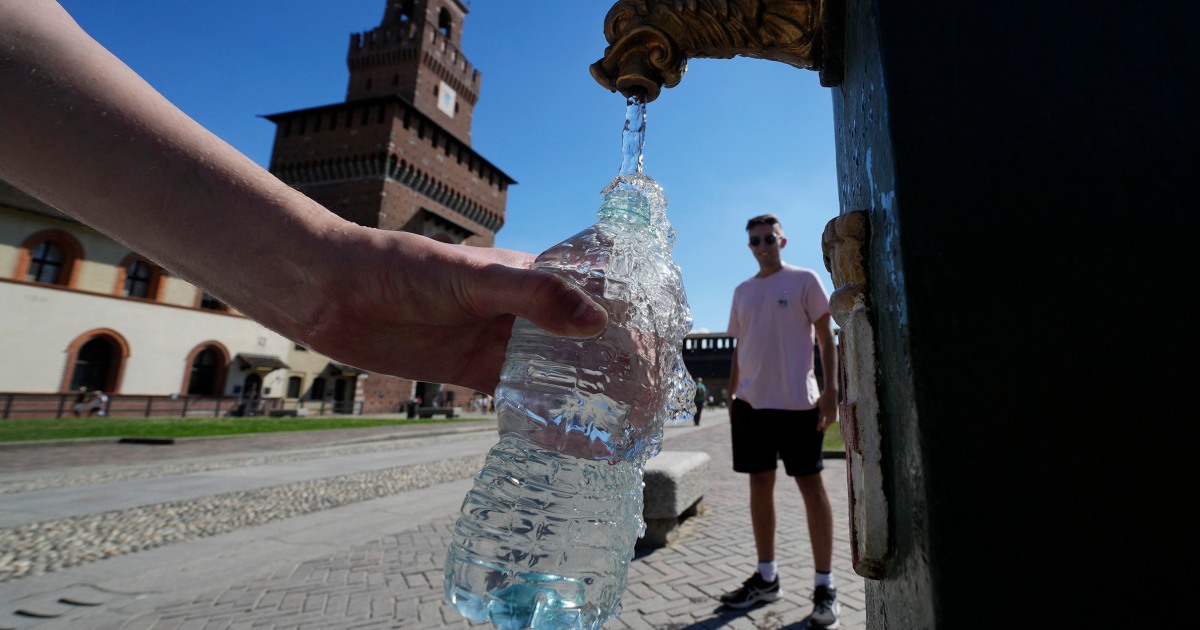The average liter of bottled water has nearly a quarter million invisible pieces of ever so tiny nanoplastics, detected and categorized for the first time by a microscope using dual lasers.
Scientists long figured there were lots of these microscopic plastic pieces, but until researchers at Columbia and Rutgers universities did their calculations they never knew how many or what kind. Looking at five samples each of three common bottled water brands, researchers found particle levels ranged from 110,000 to 400,000 per liter, averaging at around 240,000 according to a study in Monday’s Proceedings of the National Academy of Sciences.
These are particles that are less than a micron in size. There are 25,400 microns — also called micrometers because it is a millionth of a meter — in an inch. A human hair is about 83 microns wide.
Previous studies have looked at slightly bigger microplastics that range from the visible 5 millimeters, less than a quarter of an inch, to one micron. About 10 to 100 times more nanoplastics than microplastics were discovered in bottled water, the study found.
Weird how none of this is in parts per million
Calculating PPM would be meaningless because we’re trying to measure larger particles, not dissolved chemicals.
Think of salt water where you measure a concentration, versus sandy water where you count grains per liter.
Yeah that makes sense, 1nm is just so small that I half assumed we’re nearly at the size of molecules where it would make sense. Turns out a water molecule is only .27nm
1nm and ¼nm are pretty close in my book. Avagados number is pretty big.
Assuming it is PTFE, then it would be about 0.04 ppm
Researchers still can’t answer the big question: Are those nanoplastic pieces harmful to health?
“That’s currently under review. We don’t know if it’s dangerous or how dangerous,” said study co-author Phoebe Stapleton, a toxicologist at Rutgers. “We do know that they are getting into the tissues (of mammals, including people) … and the current research is looking at what they’re doing in the cells.”
Sheesh.
Do we really need more research on this? Holy shit.
Yes we do, science is better than gut feelings. Repetitive science is also necessary, reconfirming things we know is important, just because we’ve known something for a long time doesn’t mean its correct
Science has proven many times that ingesting microplastics is bad. They even found they can cross the blood brain barrier.
What we need now is to take action to stop this.
The study is about nanoplastics which are bigger. Not that you’re wrong since nanoplastics also cross the blood brain barrier (in fish), we just don’t know if they have any adverse effects on humans yet.
They probably do, but I’m not a biologist. They may have no adverse effects other than piling up at the levels we are currently consuming. The adverse effects are still being studied:
https://www.ncbi.nlm.nih.gov/pmc/articles/PMC9026096/
So to reiterate, there is no proof that the nanoplastics are bad, so we still need studies
Yes, for the same reason that mercury in vaccines isn’t a threat because it’s under the LD50.
Certain things are only an issue when they are in a specific concentration.
Scientists actually studying the issue:
“Not sure. We studying the issue.”
Lemmy:
“But I FEEL it’s harmful! I’ve done my research!”
Antivaxxer by any chance? Because you’re tracking the same thought process.
Whenever something like this comes up, of which I’m ignorant, I ask myself, “By what mechanisms could this be true or false? How would that work?”
Your turn.
Wow man. I wrote, “Sheesh.”
And you got AAAAAALLLL this:
Scientists actually studying the issue:
“Not sure. We studying the issue.”
Lemmy:
“But I FEEL it’s harmful! I’ve done my research!”
Antivaxxer by any chance? Because you’re tracking the same thought process.
Whenever something like this comes up, of which I’m ignorant, I ask myself, “By what mechanisms could this be true or false? How would that work?”
Your turn.
Yeah, I’ll pass.

Let’s fight over nothing but my assumptions and preconceptions!
Lmao…
“We don’t know yet”, and “No” are two very different answers.
Antivaxxers interpret “No [not harmful]” to mean “Yes [harmful]”.
Completely unrelated.
Use reusable bottles for fucks sake. Ima die hard Klean Kanteen and Nalgene fan
Plastics in foods go way beyond plastic bottles.
I guarantee you that a lot of that plastic was in the water before it ever touched a plastic bottle. You are eating a credit card worth of plastic a week, it has already permeated into every tissue in your body, and are even in your unborn fetus. . This is leaded gasoline all over again in that it is absolutely everywhere, everyone is filled with it, and we aren’t sure what the long term affects are going to be
I’m guessing the request was to use reusable bottles instead of single-use bottles, particularly given the fairly recent knowledge that plastic recycling is a scam
The bottled water tastes better even if you use a filter
People downvoting you probably live somewhere with decent tapwater where a filter does the job. We recently moved somewhere with absolutely garbage tap water. It isn’t even compliant with regulations. The only way to make it taste acceptable is with a reverse osmosis system.
Unless you own your own home, you can’t typically rip out the faucet that comes with the house/apartment for one that incorporates an RO system, or drill a new hole in the sink shelf to add one in. Luckily, we were able to add RO to our kitchen sink, but I completely empathize with those who aren’t so fortunate.
That’s why I buy bottled water and empty it into my reusable water bottle to get the best of both worlds
My irl friends actually do this. I’ve seen at least 3 people dump 2 bottled waters in their reusable bottle because it “tastes better”. These priveleged fucks I swear.
Edit: where we are at (school) there are water fountains everywhere and each location has the bottle refiller thing attached to them. At least 2 locations in every level of each building.
Won’t the plastics have leeched in by the time you receive the bottles?
Their reusable water bottle is probably just another plastic water bottle
He washes it out OKAY. Stuff can be two things.
Please tell me he uses bottled water to wash it out
Consider this the ultimate in “personal responsibility.” One biosphere, we created the plastic, we shall filter it out.
With our fat cells.







